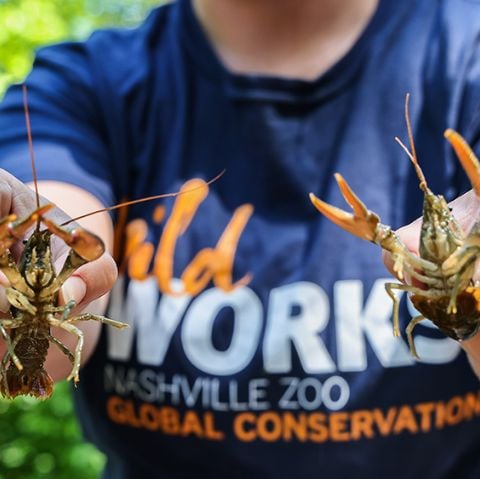Summary of Local Crayfish Conservation:
The Nashville Zoo‘s Aquatics team has been monitoring the local Nashville crayfish population as part of their conservation work. The Nashville crayfish, found only in Mill Creek and its tributaries, is endangered due to development, pollution, and agricultural run-off. The team has been researching to track population trends and monitor water quality. During their visits to Mill Creek, they recorded over 400 crayfish at four locations. Nashville crayfish are important to the ecosystem and serve as a food source for many species. To help protect the crayfish, individuals can keep local waterways clean by picking up trash and preventing pollution, ensuring no exposed soil or pollutants are left on their property, and preserving trees and native plants along streams.
– The Nashville crayfish is an endangered species found only in the greater Nashville area.
– The Nashville Zoo has been actively monitoring the crayfish’s population and water quality.
– Nashville crayfish play a valuable role in the ecosystem and are a food source for many other species.
– Individuals can help protect the crayfish and their habitat by keeping waterways clean and reducing pollution.
Did you know that right here in our Middle Tennessee neighborhood, there is a unique and fascinating creature called the Nashville crayfish? This small crustacean is not only an endangered species but also has the distinction of having its entire range located only in the greater Nashville area. You heard that right – the Nashville crayfish can only be found in Mill Creek and its tributaries. Talk about an exclusive neighborhood!
Unfortunately, the Nashville crayfish population is at risk due to development, pollution, and agricultural run-off. That’s where our Aquatics team at the Nashville Zoo comes in. Thanks to a grant from the U.S. Fish and Wildlife Service, we have worked tirelessly since 2011 to develop protocols and implement long-term population monitoring for these amazing creatures.
This past spring, our team made several visits to Mill Creek, specifically at four locations that have remained the same since the start of our project. On each visit, we carefully recorded and studied over 400 crayfish. This data helps us understand the population trends and monitor the water quality in the creek, as these factors greatly impact the survival of the Nashville crayfish.
You might be wondering, what makes the Nashville crayfish so important? Despite their small size, these crayfish play a crucial role in the ecosystem. They act as a source of food for over 240 different species, including fish, raccoons, and reptiles. Imagine if this little crayfish disappeared – it would have a significant ripple effect throughout the food chain. We need to protect and conserve these unique creatures.
So, how can you help in this conservation effort? It starts with taking care of your local waterways. Every little action counts; even the smallest water system contributes to the larger rivers where cities acquire their drinking water. Here are a few things you can do:
1. Pick up trash and other pollution before it reaches a creek or other waterway. Remember, every piece of trash left on the ground can find its way into the water and harm the crayfish and other aquatic creatures.
2. Take steps to prevent soil erosion on your property. Stormwater can easily wash away exposed soil and end up in creeks, polluting the water and harming the crayfish. Consider planting grasses, plants, and trees near the stream’s edge to help hold the soil in place.
3. Be mindful of the chemicals you use. Pesticides and other pollutants left on the ground can be carried away by stormwater and deposited in a creek. Opt for environmentally friendly alternatives whenever possible.
By following these simple tips, you can directly impact the protection of the Nashville crayfish and their habitat. It’s incredible to think that our actions, no matter how small, can make a difference in conserving such a unique and endangered species in our backyard.
The Nashville crayfish might not be the most well-known creature, but it deserves our attention and care. Let’s work together to ensure that future generations enjoy the beauty and richness of our local wildlife. After all, we can all benefit from a healthy ecosystem with a diverse array of species, even if we don’t realize it. So, let’s roll up our sleeves, get involved, and positively impact our Middle Tennessee community. Together, we can preserve the wonders of nature for generations to come.


